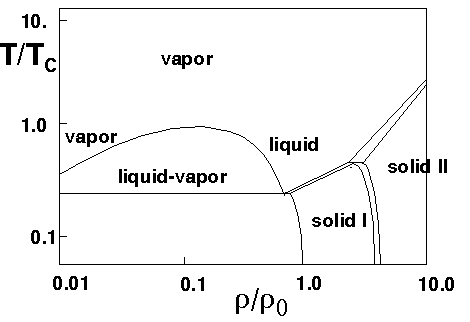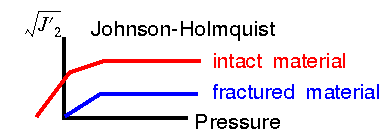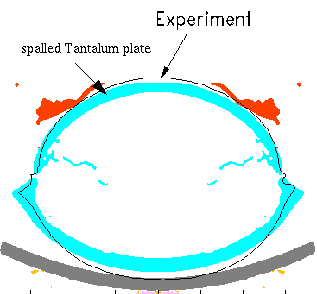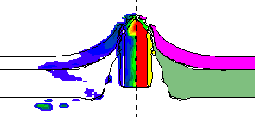CTH is a multi-material, Eulerian, large deformation, strong shock wave, solid mechanics code developed at Sandia National Laboratories. It has models for multi-phase, elastic viscoplastic, porous and explosive materials. Three-dimensional rectangular meshes, two dimensional rectangular, and cylindrical meshes, and one-dimensional rectilinear, cylindrical, and spherical meshes are available. CTH has adaptive mesh refinement and uses second-order accurate numerical methods to reduce dispersion and dissipation and produce accurate, efficient results. It is written in FORTRAN 90 and C and has serial and parallel versions for UNIX and Linux workstations, Beowulf clusters, massively parallel supercomputers, Macintosh/OSX and Windows. Serial and parallel pre-built executables for Linux, Windows (WSL) and Macintosh/OSX are available. CTH provides an end-to-end simulation solution including visualization support.
CTH calculation of a .50 cal round against a fruit
CTH reveals internal behavior as round penetrates

SESAME Multi-Phase Equation of State
CTH has several material equation of state models appropriate for strong shock, large deformation calculations. SESAME tabular and analytic equations of state model the nonlinear behavior of materials in the high-pressure regime. SESAME can model solid, liquid, vapor, liquid-vapor, solid-liquid and solid-solid phase changes.
Constitutive elastic models
CTH can incorporate constitutive elastic-perfectly plastic models with thermal softening such as the Johnson-Cook, Zerilli Armstrong, and Steinburg-Guinan viscoplasticity. In addition, the Johnson Holmquist brittle strength and failure model is available for modeling brittle materials such as ceramic or concrete.


Programmed burn, Lee-Tarver, Forestfire, and a history variable model
There are several methods of approximating high explosive detonation including programmed burn, Lee-Tarver, Forestfire, and a history variable model developed at Sandia. The Jones-Wilkins-Lee analytic and SESAME tabular equations of state can model the high explosive reaction products. Fracture can be initiated based on pressure or principal stress.
CTH 2D graphics
CTH uses an Eulerian solution scheme where the mesh is fixed in space and the material flows through the mesh. CTH uses monotone, second order convention schemes to flux all quantities between cells. It has a high-resolution material interface capturing scheme that prevents numerical breakup and distortion of material interfaces. These numerical methods reduce the dispersion and dissipation found in first-order accurate, Eulerian codes.


3D CTH Simulation
All variables can be displayed in two-dimensional and three-dimensional plots and as a function of time with CTH’s visualization software.